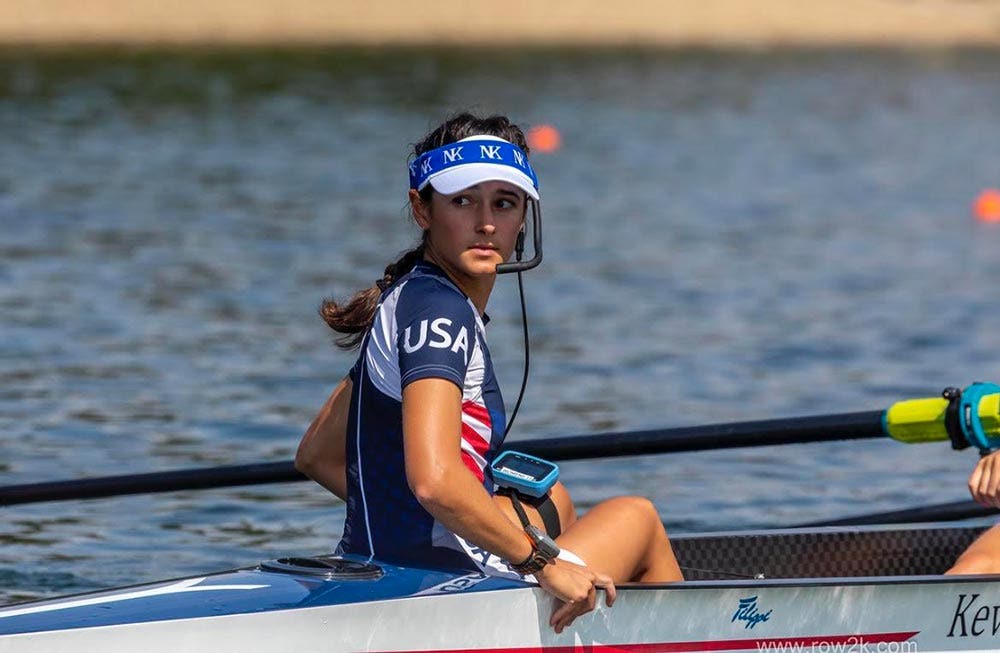Finding Her Coxing Voice: Nina Castagna

Coxswain Chronicles: Navigating the Waters of Leadership - This is Part Two of an Interview Series
How did you first get into coxing?
One of my closest friends in high school had joined a club team and would tell me all about it after school. Eventually, I was intrigued enough to come to a practice with her. I showed up to my first day, a 4'10 high school freshman excited to row and was immediately taught the ropes of coxing. I remember asking my novice coach at the end of the day, when I would get to learn the rowing portion and all she said was, "I'll check on that." It's probably a good thing that I didn't hear back on it.
What really kept you involved in the very beginning and how has that evolved over the years?
The social aspect of the sport was definitely what kept me in it at first. I coxed at a club team where there were kids from a ton of different schools, so it was a great opportunity to meet people from outside my normal social sphere. Since then, I've continued to enjoy meeting so many people from different backgrounds, many of which will be lifelong friends of mine.
Although making friends was what originally kept me attached, my love of the sport has grown in a lot of ways since then. I'd say what keeps me involved now is how much fun it is. I love getting into a boat and working together with my teammates to see how much speed we can gain over the course of a session. I've been lucky enough to be a part of three different programs now, all of which I've been able to experience this in, and it's helped my love of the sport continue to grow for over nine years now.
What was your first club like and how important were they to your growth?
I started coxing at Cincinnati Junior Rowing Club in 2015, on a small tributary just off of the Ohio River, called “The Licking.” I learned a lot about the basics of coxing, but I'd say the biggest impact the program had on me (other than inciting my love of the sport) was in my steering. Throughout my four years on the river, I became really conscious of how my steering affected our overall speed. I gained an awareness of flow (where it was and how it changed the speed of the boat), the rudder (how much movement was necessary to go where I wanted and how much would disturb the balance of the boat), and the size of the boat (exactly how close I could get to things before it became dangerous). The Licking was notorious for its debris and ever-changing flow, so I also had to be extremely aware of my course and how to make it the safest and fastest one possible.

How would you define your coxing style?
I'd say my coxing style is a bit conversational. It's been heavily influenced by some mentors and coaches that I've had in the last few years, but I've found that I really enjoy talking to my athletes, more so than at them. Instead of constantly calling for the entire group to improve an aspect of the stroke, I like to find someone that I think can lead us into that focus, then empower them to do so with a call. It's really exciting to feel them respond in a physical way and empower those around them in the process. That verbal and nonverbal back and forth is an extremely cool experience to be a part of and makes racing feel way more intimate to me.
In your opinion, what is the most important attribute a successful coxswain must imbue?
Definitely trustworthiness. I've found that if the coxswain can be fully trusted by their crew and coaches, then everyone will be able to do their job at the highest level.
What has been your favourite coxing memory?
I've had a ton of great memories during my time coxing, so it's really challenging to pick just one. I will say I've had a lot of fun racing at the Head of the Charles and the Windermere Cup over the last few years. Both races have such an electric environment and I love getting to make an impact on a race with my steering.
How did your experiences at UoW shape your journey to the national team?
I had the opportunity to work with a lot of different types of people over my five years at UW. There were some years where the majority of our squad had won championships before and represented their home countries on the international stage, whereas in other years almost none had. I learned fairly quickly that these different groups would require slightly different leadership and coxing as a result. My experience working with and being a part of such a variety of boats has given me a great deal of perspective on how to best support different kinds of people, on and off the water. This has really helped prepare me for the national team, where almost everyone differs in what they'll want and need from me.
As far as developing my ability as a coxswain specifically, I had some of the best support and resources in the world during my time at UW. Off the water, we would have weekly meetings to review recordings, fleet management, data, and more. Having that many different brains in one room to share perspective on whatever it was we were looking at was always helpful. On the water, I'd get to practice my steering and management of workouts, as well as develop my coxing style and boat feel. Great feedback from athlete evaluations and coaches alike always gave me room to improve and kept me wanting to do so.

What influence did Yaz personally have on your development?
From the first day I stepped foot into the boathouse at UW, Yaz began to preach the ideology that we wanted every team to show up at their best, so that they could push us to be our best. She steered us away from the idea of beating down the opposition and instead towards an excitement for creating our own boat speed. From there, so much of her messaging was about separating ourselves from the outcome, enjoying the experience, and empowering the people around us, all of which are now central to my perspective of rowing. I doubt my love of the sport would be nearly as powerful without this influence.
She was also extremely influential in the development of my coxing style as well. I had been in the Varsity 8+ for a year when I first told her I might be interested in trying to cox at the senior level. From that point on, the feedback she would give me about my coxing was way more tuned to what would be effective at the senior level, and not just at the collegiate level. It definitely took some trial and error over the next few years to get comfortable with the style, but by the time I graduated, I felt well prepared to try and make an impact on the US team.
What was the biggest learning curve during your coxing journey and how did you tackle it?
I think the biggest learning curve of my journey has been the adaptation of my style— especially in those last two years of college. I found the style I was being coached on at that point really challenging to grasp and I just couldn't seem to do it in a way that was comfortable. As a result, I didn't make many improvements in my senior year. Honestly, it wasn't until my fifth year when I had a chance to listen to one of our mentors, Mary Whipple, cox live that it all started to make sense to me. From there, I felt like I finally had a real understanding of the style and was able to start implementing it with my own.
What is the one bit of advice you'd give to a new cox trying to find his or her voice?
Be open to feedback! There is no level of coxing in which you are too good for feedback, so be open to the process of learning and growing. If you are, your coaches and teammates will give you the guidance you need, and you'll have your voice in no time.
How crucial is high-quality equipment (like NK) to set you up for success?
Having consistently functioning, high-quality equipment is essential to me for success. From the obvious necessities like a working microphone, to bonus features like the stroke counter on an NK CoxBox or SpeedCoach, good equipment makes it easier for me to focus on the parts of the job that the equipment can't do.







